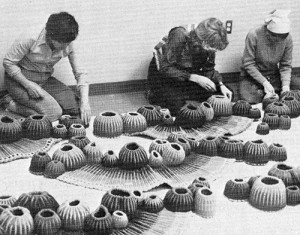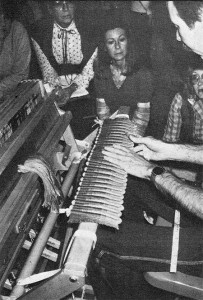Beata I. Fergin wrote, “The Hand Weavers’ Guild of the Inland Empire was organized May 23rd of 1948 by fifteen women and men as charter members.”
In the late 1940s and early 1950s meetings were held at members’ homes. To apply to join the guild at that time you were expected to submit three finished pieces demonstrating that you had acceptable skill as a weaver, have a guild member sponsor you and be voted in by a majority of the membership.
The third Pacific Northwest Weaving Conference was held in Spokane, May 26 – 28, 1967, at the Davenport Hotel. One of the opening events of the conference was a style show of fashions and accessories made of handwoven materials. Approximately 118 garments and 12 accessories were modeled by women from all over the state.
By 1968 the guild met in a variety of public places, such as the Corbin House, the REA building, Finch Arboretum,and the Inland Power and Light Company building.
By summer of 1979 The Inland Empire Hand weavers’ Guild was mailing out a newsletter on stationery designed by B. Carsrud, a simple graphic of 5 heddles with a warp end centered in each eye. The news for June was that the Ninth Biennial Conference of the Association of Northwest Weavers’ Guilds (ANWG) was to be held June 14-17, 1979 on the campus of Whitworth College. Space for all interested guilds was a concern, as the number of associated guilds had increased from forty-six to fifty-nine between June of 1977 and the time of the conference in 1979.
Between 1979 and 1981 the name was changed from Inland Empire Weavers’ Guild to The Spokane Handweavers’ Guild and the group became a Washington State public benefit corporation and gained 501(c)3 status with the IRS.

Betty Lukins, Sandy McKell and Suzie Jewell work on Seaforms in 1979. Photo from Handwoven magazine, Sept. 1982
In 1982 an ambitious Guild Project was undertaken. A 8-foot by 16-foot wall hanging was commissioned by the Spokane Arts Commission for the new City Hall. Titled “Seaforms: Barnacles and Fans,” the piece was a marine-inspired mural designed by Ken Weaver, a noted Atlanta fiber artist.
Mr. Weaver designed and supervised the weaving and installation. Guild members donated the labor, materials, weaving time and installation. Many hundreds of hours of weaving, construction, and wall painting were contributed by 29 Guild members. There are 250 Barnacles and 12 Fans covering the wall on the lobby level of the City Hall. It is an imposing and unusual piece and is open to viewing daily.
The project for 1984 was a 10-foot by 10-foot wall hanging woven for the Council Chamber in City Hall. Introduced June 1984 at the general meeting, this project was finished and ready to transport by March 1985. Betty Lukins supervised the design and 20 guild members in the Finn Weave Workshop donated the weaving of 63 large square panels in 27 colors representing Spokane as the Heart of the Inland Empire, surrounded by lakes,rivers, streams, hills forest, fields and mountain. D. and B. Roark organized the assembly, mounting and transportation of the completed piece to the ANWG Conference in Eugene, Oregon, where it won top honors. They also returned it to Spokane and mounted it in the City Hall. Our Guild has a scrapbook devoted to this unique project.
In the nearly 70 years that this organization has existed, American handweaving has seen several eras of fashion pass. Through them all, handcrafters continue to meet, to work and to study. The real history of this Guild lies in the information stored in the mind and home of each person who has ever been a loyal and dedicated officer or committee member, without whom our volunteer group would cease to exist.
———–
This short history is based on writings by P. Lersch, long-time guild historian, which are stored in the guild scrapbooks. Other members also were generous with comments and additions to these records. B. Lukins was especially helpful with information and support. P. Daniels was always willing to verify photos. Many other long-time guild members have had a hand in building this history.
J. Olsen,
Guild Historian/Archivist
Updated September 2013

